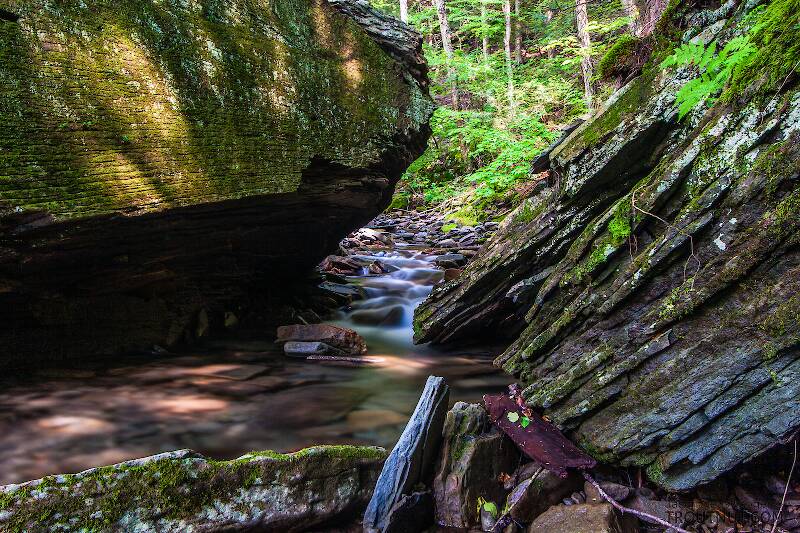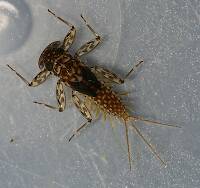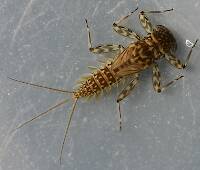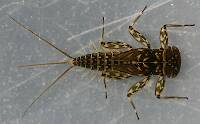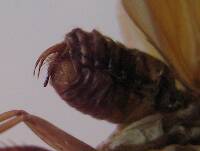
Blue-winged Olives
Baetis
Tiny Baetis mayflies are perhaps the most commonly encountered and imitated by anglers on all American trout streams due to their great abundance, widespread distribution, and trout-friendly emergence habits.
Featured on the forum

Troutnut is a project started in 2003 by salmonid ecologist Jason "Troutnut" Neuswanger to help anglers and
fly tyers unabashedly embrace the entomological side of the sport. Learn more about Troutnut or
support the project for an enhanced experience here.
Pbaerman on May 9, 2007May 9th, 2007, 8:46 am EDT
OK, i have no pictures as i did not have my camera this day. I was fishing a stream near my home in SE Minnesota and was having a decent day with some nice browns on a black wolly bugger. Then I hooked into a small mouth as I landed it I noticed it was full of some sort of insect. I grabbed the plyers to examine. So I look at it and decide I have never come across this before. I took a mental not and did some research. Came up empty. To get to my question, the bug looked quite a bit like a Helgramite (similar in size, legs, shape) but the color was nothing I have ever come across. It had a deep brown head and a solid grey body. Is this some form of Helgramite, or is it something defferent all together? I will understand if not much help is added since I have no pics to help but just thought I wuold throw it out there.
Thanks
Pete
Thanks
Pete
Many men go fishing all of their lives without knowing that it is not fish they are after. ~Henry David Thoreau
Taxon on May 9, 2007May 9th, 2007, 9:15 am EDT
Peter-
Absent a photo, it would help if you painted a more complete verbal description of the body size, shape, and appendages, as you have already done concerning color. There are numerous possibilities, and this can serve to narrow them down.
Absent a photo, it would help if you painted a more complete verbal description of the body size, shape, and appendages, as you have already done concerning color. There are numerous possibilities, and this can serve to narrow them down.
Pbaerman on May 9, 2007May 9th, 2007, 10:01 am EDT
I will give it a shot Taxon. It was about one inch long and heavy bodied. The body was no larger than the head. Dark brown head with large mandibles and maybe 8ish legs on each side.
Many men go fishing all of their lives without knowing that it is not fish they are after. ~Henry David Thoreau
Taxon on May 9, 2007May 9th, 2007, 11:20 am EDT
Peter-
Given the size you mention (1 inch) and obvious mandibles narrows it down somewhat. Insect larvae with jointed legs have only three pair, which are attached to the thoracic segments. The abdominal segment appendages you are describing are called lateral filaments.
In any event, the range of possibilities would likely be limited to larvae of dobsonflies (often called hellgrammites), larvae of fisflies, larvae of alderflies, and larvae of water scavenger beetles.
They can most easily be distinguished from one another based on the appearance (or absence) of appendages at the end of the abdomen.
Alderfly larvae have a single tapered terminal filament.
Both dobsonfly and fishfly larvae have two terminal prolegs, each with a pair of hooks, but fishfly larvae also have a pair of breathing tubes, and dobsonfly larvae have gill tufts at the base of each lateral filament.
Those water scavenger beetle larvae which posess lateral filaments usually don't have anything particularly noteworthy at the end of the abdomen.
Given the size you mention (1 inch) and obvious mandibles narrows it down somewhat. Insect larvae with jointed legs have only three pair, which are attached to the thoracic segments. The abdominal segment appendages you are describing are called lateral filaments.
In any event, the range of possibilities would likely be limited to larvae of dobsonflies (often called hellgrammites), larvae of fisflies, larvae of alderflies, and larvae of water scavenger beetles.
They can most easily be distinguished from one another based on the appearance (or absence) of appendages at the end of the abdomen.
Alderfly larvae have a single tapered terminal filament.
Both dobsonfly and fishfly larvae have two terminal prolegs, each with a pair of hooks, but fishfly larvae also have a pair of breathing tubes, and dobsonfly larvae have gill tufts at the base of each lateral filament.
Those water scavenger beetle larvae which posess lateral filaments usually don't have anything particularly noteworthy at the end of the abdomen.
Pbaerman on May 10, 2007May 10th, 2007, 2:46 am EDT
Thank you Taxon for the information. If you could not tell I am far from an entemologist and have only about three years of fly fishing under my belt. I did a bit more searching with your seggestions and I think it was a fishfly larvae. I did find a photo that nearly matched what I found.
Now I at least have an idea that I can take to the stream.
Now I at least have an idea that I can take to the stream.
Many men go fishing all of their lives without knowing that it is not fish they are after. ~Henry David Thoreau
Taxon on May 10, 2007May 10th, 2007, 8:04 am EDT
Peter-
You are certainly welcome. If you can get a photo next time, more identification help can be provided. And, remember to take the photo with the larval specimen submerged in water within a jar lid with a white background (or something equivalent), so all body appendages are in full display.
You are certainly welcome. If you can get a photo next time, more identification help can be provided. And, remember to take the photo with the larval specimen submerged in water within a jar lid with a white background (or something equivalent), so all body appendages are in full display.
Quick Reply
Related Discussions
Topic
Replies
Last Reply
5
Jun 28, 2011
by PaulRoberts
by PaulRoberts
4
Sep 27, 2014
by Millcreek
by Millcreek
3
Dec 10, 2015
by PaulRoberts
by PaulRoberts

